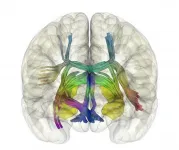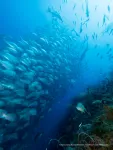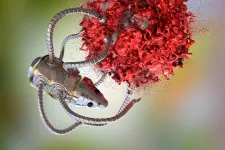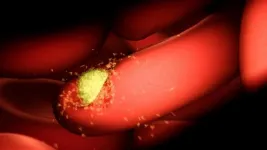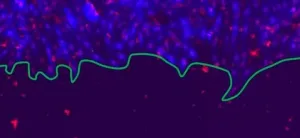INFORMATION:
Publicly available article: https://journals.plos.org/plosone/article?id=10.1371/journal.pone.0250853
Article Title: Investigation of SARS-CoV-2 infection in dogs and cats of humans diagnosed with COVID-19 in Rio de Janeiro, Brazil
Funding: MMS: This study was supported by CGLab/MoH (General Laboratories Coordination of Brazilian Ministry of Health), CVSLR/FIOCRUZ (Coordination of Health Surveillance and Reference Laboratories of Oswaldo Cruz Foundation), The National Council for Scientific and Technological Development (CNPq) COVID-19 MCTI 402457/2020-0, INOVA VPPCB-005-FIO-20-2-69, and Carlos Chagas Filho Foundation for Research Support of the State of Rio de Janeiro (FAPERJ) E26/210.196/2020.
Competing Interests: The authors have declared that no competing interests exist.
Article URL: https://journals.plos.org/plosone/article?id=10.1371/journal.pone.0250853
31% of dogs and 40% of cats tested positive to COVID-19 after owners' diagnoses
2021-05-03
(Press-News.org) 31 percent of pet dogs and 40 percent of pet cats tested positive to COVID-19 after their owners' own diagnoses, though under half displayed symptoms, in small Brazilian study.
ELSE PRESS RELEASES FROM THIS DATE:
The neural mechanism of autonomous learning uncovered by researchers at IBEC
2021-05-03
Thanks to the so-called deep learning, a subset of artificial intelligence (AI) algorithms inspired by the brain, machines can match human performance in perception and language recognition and even outperform humans in certain tasks. But do these synthetic biologically inspired systems learn in the same way that we do?
According to a new article by first author Dr. Diogo Santos-Pata from the Synthetic Perceptive, Emotive and Cognitive Systems lab (SPECS) at IBEC led by ICREA Professor Paul Verschure, in collaboration with Prof. Ivan Soltesz at Stanford University, the mechanism of autonomous learning underlying these AI systems reflects nature more closely than previously thought. With their hypothesis and model, these scientists offer new insights into ...
Limited fishing zones support reef conservation
2021-05-03
A world first study within the Great Barrier Reef Marine Park has found limited fishing zones (yellow zones) are still important conservation and fisheries management tools when paired with no-fishing zones.
Lead author Dr April Hall, from the ARC Centre of Excellence for Coral Reef Studies at James Cook University (Coral CoE at JCU), said partially protected yellow zones still contain healthy numbers of reef fish targeted for recreational and commercial fishing. These include coral trout, tropical snappers, emperors and tuskfish.
Yellow zones limit, rather than prohibit, fishing through fishing gear restrictions. For example, limited line fishing is allowed with one rod or line and one hook per ...
Nanotechnology offers new hope for bowel cancer patients
2021-05-03
Bowel cancer survival rates could be improved if chemotherapy drugs were delivered via tiny nanoparticles to the diseased organs rather than oral treatment.
That's the finding from Indian and Australian scientists who have undertaken the first study, using nanoparticles to target bowel cancer, the third most common cancer in the world and the second most deadliest.
The researchers have shown in animal experiments that nanoparticles containing the chemotherapy drug Capecitabine (CAP) attach themselves directly to the diseased cells, bypassing healthy cells and therefore reducing toxic side effects as well as the size and number of tumours.
The scientists, from the Manipal Academy of Higher Education, Indian Institute of Science and the University of South Australia, ...
Natural immunity to malaria provides clues to potential therapies
2021-05-03
National Health and Medical Research Council, the European Research Council and the Victorian Government.
WEHI researchers have identified how natural human antibodies can block malaria parasites from entering red blood cells, potentially indicating how new protective therapies could be developed against this globally significant disease.
The research provides greater insight into how antibodies block the entry of Plasmodium vivax malaria parasites into young red blood cells called reticulocytes. It builds on an earlier discovery that the P. vivax latches onto the transferrin receptor 1 (TfR1) to enter cells.
The research, led by Associate Professor Wai-Hong Tham and PhD student Li-Jin Chan ...
Risk factors for multiple drug use
2021-05-03
Many drug addicts take not only one substance but rather several. Scientists at the Max Planck Institute of Experimental Medicine in Göttingen have investigated the role that genes and the environment play in the development of such multiple substance consumption or polytoxicomania. Their results show that, in addition to genetic factors, the accumulation of several unfavourable environmental factors causes people to slip into such an extreme form of multiple drug use. Among the risk factors were sexual and physical abuse, living in a big city, and migration experience as well as the use ...
Understanding aromaticity in catalysis to unlock new opportunities
2021-05-03
Aromaticity, a concept usually used to explain the striking stability and unusual reactivity of certain carbon-based molecules, could inspire the design of new catalysts with novel uses, KAUST researchers have shown.
Chemists first came upon the anomalous behavior of aromatic molecules in the nineteenth century while studying benzene. The unexpected stability of this six-carbon cyclic structure comes down to its electrons.
In general, bonding electrons hold a specific pair of atoms together in a discrete chemical bond. But in benzene, six electrons form a delocalized ring across the molecule. A host of other molecules share this feature. "Many classic examples of organic and organometallic reactivity can be explained on this basis," says Théo Gonçalves, ...
A physics perspective on wound healing
2021-05-03
In material physics understanding how systems interact across the interfaces separating them is of central interest. But can physical models clarify similar concepts in living systems, such as cells? Physicists at the University of Geneva (UNIGE), in collaboration with the University of Zurich (UZH), used the framework of disordered elastic systems to study the process of wound healing - the proliferation of cell fronts which eventually join to close a lesion. Their study identified the scales of the dominant interactions between cells which determine this process. The results, published in the journal Scientific Reports, will allow better analysis of cell front behaviour, in terms of both wound healing and tumour development. In the future, this approach may offer personalised diagnostics ...
Lead found in rural drinking water supplies in West Africa
2021-05-03
Scientists are warning that drinking water supplies in parts of rural West Africa are being contaminated by lead-containing materials used in small community water systems such as boreholes with handpumps and public taps.
They analysed scrapings taken from the plumbing of 61 community water supply systems in Ghana, Mali and Niger. Eighty percent of the tested systems had at least one component that contained lead in excess of international guidance.
Lead is released into the water when the components corrode.
The study, by a research team from the University of Leeds, University of North Carolina at Chapel Hill and Boston University, also took samples of the water from those 61 water distribution systems, ...
Reduction in wetland areas will affect Afrotropical migratory waterbirds
2021-05-03
Migratory waterbirds are particularly exposed to the effects of climate change at their breeding areas in the High Arctic and in Africa, according to a new study published in Bird Conservation International. The research team came to this conclusion after modelling climatic and hydrological conditions under current and future climate scenarios (in 2050) and comparing the impact on the distribution of 197 of the 255 waterbird species listed under the Agreement on the Conservation of African-Eurasian Migratory Waterbirds (AEWA). The international team was led by Wetlands International, BirdLife International, and the British Trust for Ornithology, involved researchers from various universities, including McGill. The results suggest that investing more in habitat conservation in the wider ...
NTU Singapore scientists invent catheter system to deliver electricity-activated glue path
2021-05-03
A team of researchers led by Nanyang Technological University, Singapore (NTU Singapore) has developed a device that offers a quicker and less invasive way to seal tears and holes in blood vessels, using an electrically-activated glue patch applied via a minimally invasive balloon catheter.
This device could eventually replace the need for open or keyhole surgery to patch up or stitch together internal blood vessel defects.
After inserting the catheter into an appropriate blood vessel, the glue patch - nicknamed 'Voltaglue' - can be guided through the body to where the tear is located and then activated using retractable electrodes to glue it shut in ...
